By Tom Martin | March 13, 2020
In our previous post, we discussed the history of Chicago’s alleyway and gridded street system. With an alleyway network of more than 1,900 miles, we dug into how Chicago’s alleyways came to be. Building upon this history, we investigate the various typologies of Chicago alleyways. As is with any urban form, alleyways are more localized, context specific, and diverse than the archetypal ‘urban alleyway.’
Close your eyes and picture an alleyway. What do you see? How do you feel? How quickly do you want to transition your mind to something else? It is likely that your imagination was less than flattering, eliciting scenes of a drab corridor lined with trash, rats, weeds, and telephone poles. While this is an unfortunate reality in some alleyways, it hardly represents the full potential of what they can be. This is especially true in Chicago, where alleyways span many scales, forms, characters, and uses.
An alleyway is defined as “a narrow passage behind or between buildings.”1 This definition leaves room for infinite iterations. Because we want to get you home before dinner, let’s boil it down and address six varieties of alleyways in Chicago.
.
#1. Urban Service Alleyway
Primary Neighborhoods/Locations: Loop, River North, Streeterville, West Loop
Scattered throughout the most dense areas of Chicago, the urban service alleyway is often defined by large-scale adjacent buildings, service delivery bays, back entryways, and Escher-esque fire escapes. It is typical for these 20’-28’ alleyways to bisect the center of blocks. While the initial town plat of 1830 included eighteen-foot-wide alleyways running east-west in the Loop & River North, and north-south in West Loop, decades of re-development has altered many of the original orientations and widths.
Regularly clogged with semi-trucks and dumpsters, comfortable space is uncommon within urban service alleyways. Combine this with their inherently dark and damp character, and it is clear why this alleyway typology does not often lead to pedestrian usage. However, in areas short on space, removing trash and delivery from primary thoroughfares has served Chicago well.
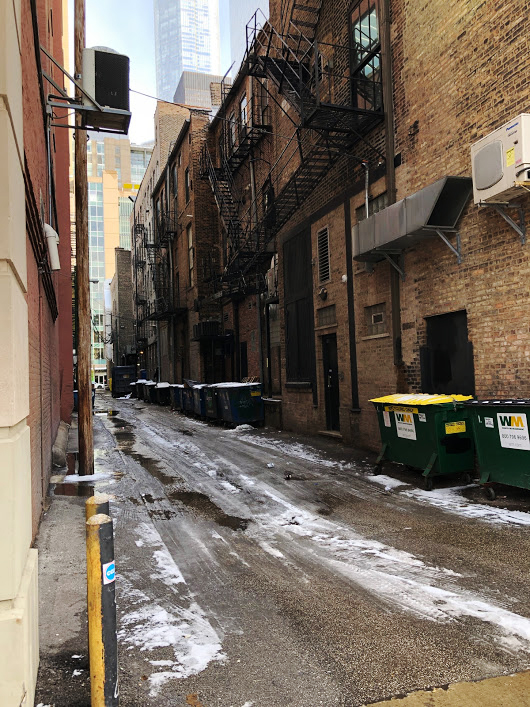
Urban Service Alleyway in River North
.
#2. Primary & Secondary Residential Alleyway
Primary Neighborhoods/Locations: Everywhere but Downtown
Undoubtedly Chicago’s most common typology, “90 percent of residential blocks have alleyways”2, equating to tens of thousands of residential alleyways. Commonly spanning 16’-20’ in width, the residential sibling to the urban service alleyway is scaled down in several ways: including narrower widths, shorter structures, and smaller trash receptacles. Residential alleyways generally connect and occupy two parts of residential blocks within the Chicago grid system. The first, which we will define as the ‘primary residential alleyway,’ bisects the block, connecting two circumscribing streets. The second, which we will define as the ‘secondary residential alleyway,’ connects the primary residential alleyway with a street.

Residential Alleyway in Ukrainian Village
Beyond their orientations, the primary and secondary alleyways don’t differ much in their compositions, providing space for trash collection, rear/side vehicle access, and mid-block pedestrian cut throughs. Serving important uses in health, access, and utilities, these residential alleyways are viewed as the ‘capillaries’ connecting to the streets, or ‘arteries.’
.
#3. Green Alleyway
Primary Neighborhoods/Locations: Pilot program included locations near Calumet Heights, Morgan Park, Andersonville, Bucktown, and Hermosa.
Piloted in 2001, Chicago’s Green Alley Initiative has aimed at “improving our environment”3 through “showcasing innovative, environmental technologies…, reducing heat in urban areas, (and) promoting the recycling and conservation of energy.” In 2006, five alleyways were included in a pilot program to investigate the success of various green alleyway techniques. These alleyways explored several strategies to improve conditions, including permeable asphalt/concrete, high albedo concrete, and pitched pavement for positive drainage. To date, every pilot alleyway—with the exception of the permeable asphalt alleyway— “did not show any freeze-thaw deterioration”4 a decade after implementation.
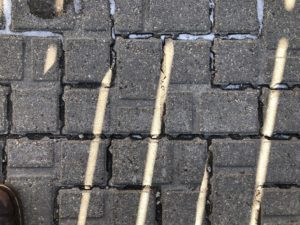
Permeable Pavers in Logan Square
The success of the Green Alley Initiative extends beyond addressing flooding and drainage issues. Many green alleyways have also implemented energy-efficient dark sky compliant figures to counter urban light pollution, and high albedo pavement to combat urban heat island effect. Since the initiative’s start in 2001, over 300 green alleyways have been installed. Chicago’s current Mayor, Lori Lightfoot, has yet to address whether the program will continue under her administration.
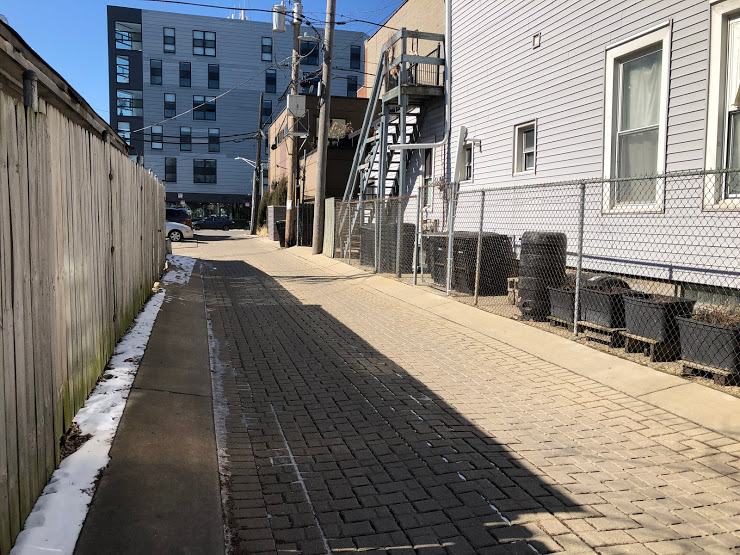
Green Alleyway with Permeable Pavers Near Milwaukee Ave.
.
#4. Historic Brick/Wood Paved Alleyway
Primary Neighborhoods/Locations: Gold Coast, Lincoln Park, West Loop, Logan Square, Wicker Park, Pilsen
Today, you’ll find most of Chicago’s alleyways and streets paved with asphalt. Though currently viewed as cheap and plentiful, historically asphalt hasn’t always been an option. In the 19th century, 4”x5” wooden pavers were a favored material due to the abundant supply provided by “Nicholson Pavement”5, a manufacturer out of Boston. Initially using white pine and then white oak, cedar wood eventually became the wood of choice. Contrary to logic, many wooden paver alleyways were not lost due to the Chicago Fire of 1871, but instead have either been removed due to degradation, or have been paved over. Only three known wooden alleyways remain: including one near Lake Shore Drive that has been preserved as a historical landmark.
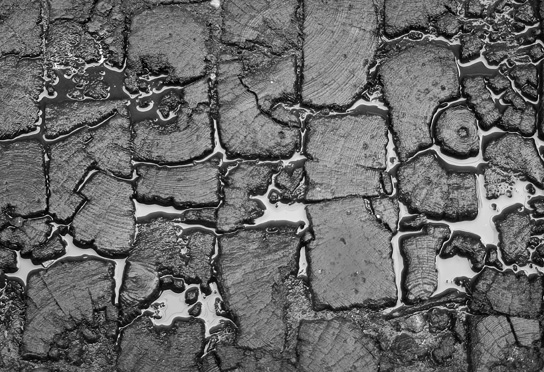
Wooden Pavers after rain. Photo by Serhii Chrucky
Granite or clay brick pavers replaced the wooden block as the primary material for alleyway pavement. Only granite pavers survived a century of use in the streetscape, while examples of clay pavers still remain in neighborhoods like Logan Square. Pavers provide several benefits: durability, ease of repair, and subgrade access that is typically limited by asphalt and concrete pavement.
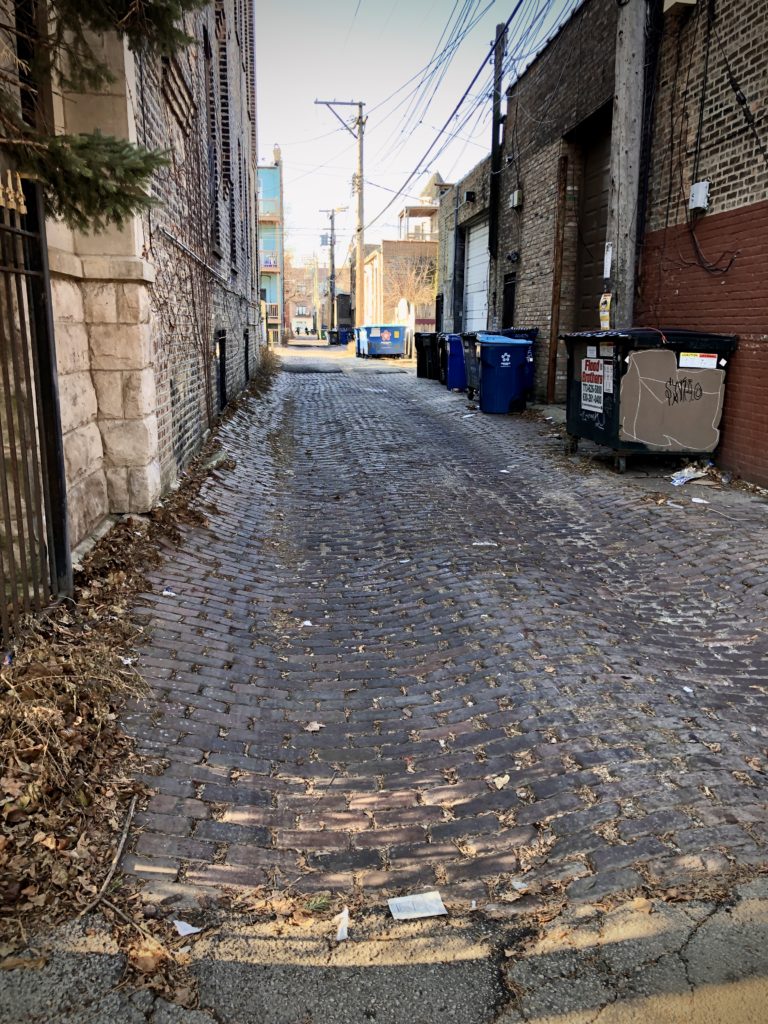
Clay Brick Alleyway Near North Ave.
.
#5. Commercial Use Alleyway
Primary Neighborhoods/Locations: Loop, Lakeview, Wicker Park, River North
Look to cities like Tokyo, Melbourne, Paris, and even San Francisco, and you’ll find innumerous businesses that open up to the alleyway, rather than the primary frontage street. Frequently derived from street culture in an era before cars, these alleyways are used as pedestrian-scaled places of commerce and gathering. While Chicago’s alleyways serve an important utilitarian purpose, there is a distinct lack of commercial use alleyways in Chicago. Future Firm questions whether “alleys and garages can become equitable civic spaces,”6 citing code restrictions as limits to developing alleyways as vibrant spaces. Additionally, Chicago’s historic pragmatism towards alleyway use and grid structure minimizes opportunity for deviation from the typical.
With that said(!), there are still some standout businesses that utilize their alleyways in notable ways. For instance, one unique example of alleyway use is the Hero Coffee Bar, which occupies the former stable in the Pickwick Place alleyway. With an emphasis on the cozy scale, the Tribune once suggested “if Harry Potter lived in Chicago, he’d find his way…along tiny cobblestone Pickwick.”7 Other businesses such as Three Dots and a Dash and Room 13 utilize humble alleyways for secretive access to their speakeasies. This could be as much a condemnation of how inviting Chicago alleyways are as it is a suggestion of their acceptance in current culture, but we will save that discussion for another post.
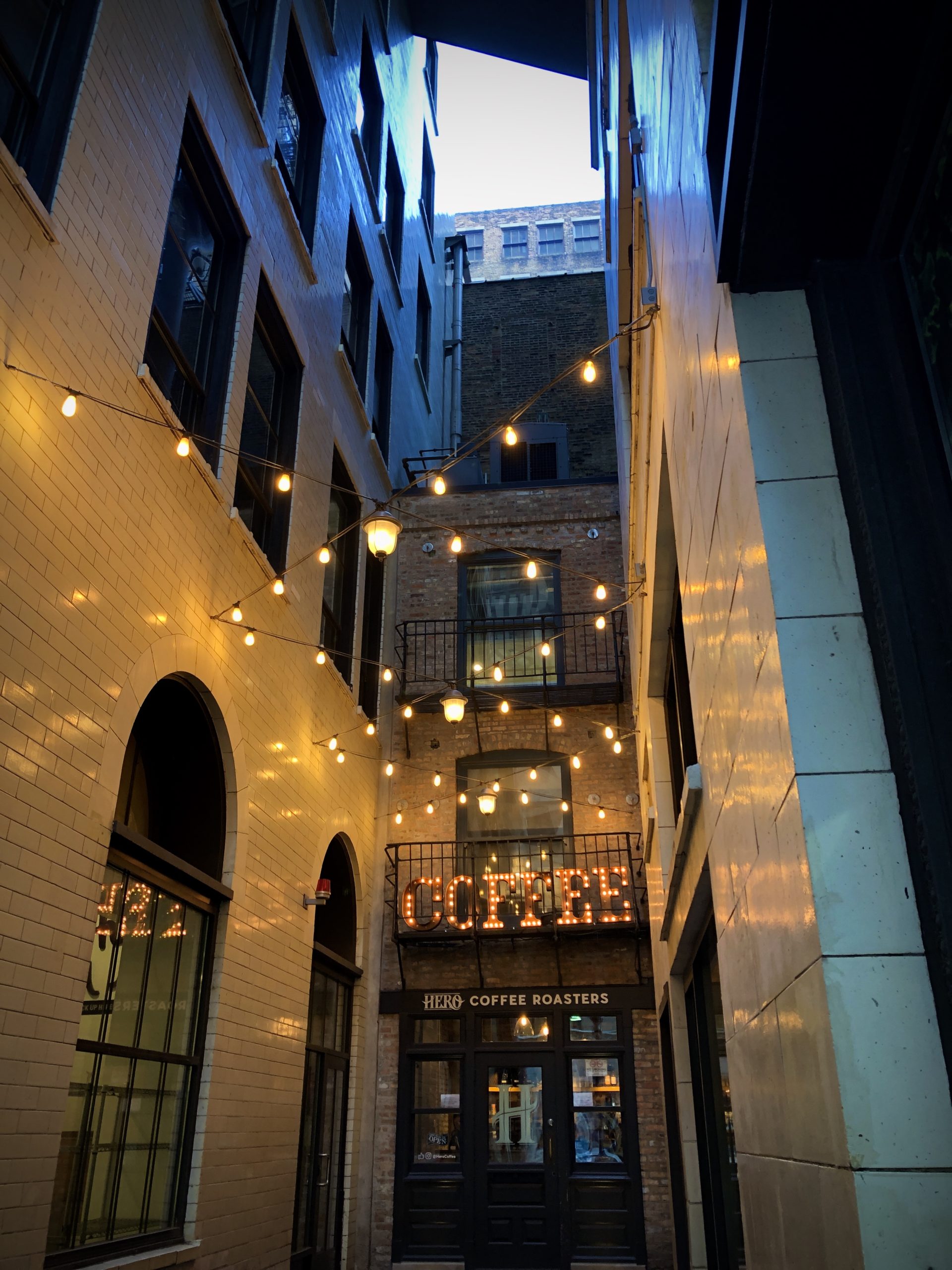
Pickwick Place or Diagon Alley?
.
#6. Street Art Alleyway
Primary Neighborhoods/Locations: Pilsen, Logan Square, South Loop (near Wabash)
It is evident that commercializing an alleyway in Chicago is a process steeped in bureaucracy and red tape. Street art, however, allows for a much more fluid and flexible process. In fact, the City of Chicago recently launched a “public mural registry”8 that allows artists to catalog their works and shield their art from an otherwise brief existence. This encouragement of street art by a municipality allows for citizens to beautify otherwise drab spaces (like alleyways) in a highly place-specific manner.
Today, several communities in Chicago have embraced street art as a way to express their values and heritage. Pilsen, in particular, does this as well as any other neighborhood in Chicago. Despite its namesake and initial presence of Czech immigrants, Pilsen is a vibrant neighborhood with decades old Mexican roots. With the famous 16th Street murals bringing a railroad embankment wall to life, the artistic spirit of Pilsen can be found permeating alleyway walls in every corner of the neighborhood. What differentiates Pilsen’s collection of street art is the promotion of “art as activism.”9 Artists like Mario Castillo, Aurelio Diaz, Hector Duarte, and Sam Kirk have produced art commenting on war, immigration, emotion, and unity. As a result, artists in Pilsen have transformed their alleyways from spaces of gloom to spaces of inspiration.

Quetzalcoatl 18 by Rocio Urbano along 18th Street in Pilsen
It is reasonable to have previously viewed alleyways as spaces of utility and grime, rarely differentiating much from one to another. It is also important to recognize the potential of alleyways to become vibrant places of social life, creative expression, and even greater utility. In a city like Chicago, where foresight and a comprehensive approach to planning has yielded an extensive and uniform network of alleyways, looking to local successes in environmental, commercial, and art-based adaptations is crucial. The 1,900+ miles of alleyways in Chicago should not just be looked at as a health and safety asset, but also as an asset in cultural, commercial, and environmental progress.
Works Cited
1 Alley: Definition Of Alley By Lexico https://www.lexico.com/en/definition/alley
2 Alleys and the Making Of Chicago’s Shadow City Steven Jackson – https://www.wbez.org/shows/curious-city/shadow-city-how-chicago-became-the-countrys-alley-capital/3f2b1e3d-f5f2-49c2-a3b8-8fb3fceacdc4
3 The Chicago Green Alley Handbook an Action Guide To Create a Greener, Environmentally Sustainable Chicago Chicago Department Of Transportation – 2007
4 “Chicago’s 2006 Green Alley Pilot Program – How Are the Alleys Performing?”, ASCE Illinois Section News, Volume 59 Jerome McGovern P.E. – Fall 2018
5 “Wood Block Alleys: Forgotten Chicago: History, Architecture, and Infrastructure Serhii Chrucky – December 2008 – https://forgottenchicago.com/articles/wood-block-alleys/
6 Lui, Ann, and Craig Reschke. Rebel Garages. Chicago Architecture Center, 2016.
7 “The Alleyway through Time.” Chicago Tribune, 27 July 2004, https://www.chicagotribune.com/lifestyles/chi-0407270047jul27-story.html.
8 “Mural Registry.” City of Chicago :: Mural Registry, www.chicago.gov/city/en/depts/dca/supp_info/mural_registry.html.
9 Scannell, Kaitlynn. “Pilsen Murals Blend Art and Activism.” WTTW Chicago, 24 Sept. 2019, interactive.wttw.com/my-neighborhood/pilsen/art-as-activism.